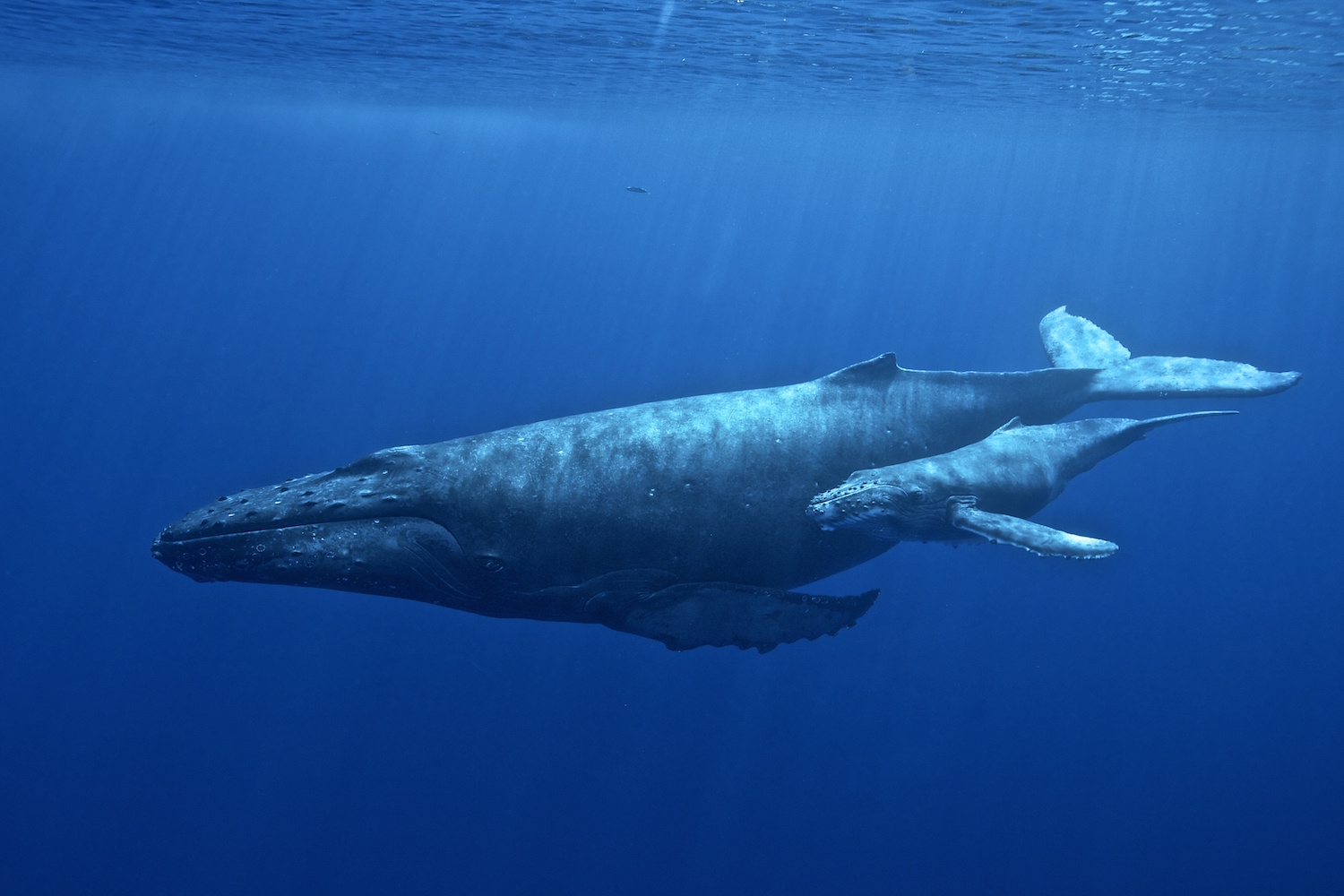Images by Flip Nicklin
On a small boat off the coast of Maui, David Rothenberg watches a whale surface and then abruptly disappear. The animal’s dive into the depths of the island’s quiet winter waters is Rothenberg’s cue that the start of a performance is near.
A philosopher and jazz musician, Rothenberg hurriedly unpacks his clarinet. He shapes his lips to the mouthpiece and blasts into the instrument a steady stream of air. An underwater speaker delivers the resulting warm, velvety sound 50 feet underwater, where a whale, presumably the one Rothenberg spied off the starboard bow, can be heard letting out a low-pitched wail.
For a while, Rothenberg lowers his clarinet and listens. The whale’s song, picked up by an underwater hydrophone, plays in his headphones at an adjusted speed to account for the movement of sound in water. A data visualization of the whale’s bluesy bellows will later reveal the sound as a series of long, repeated phrases, no different than any modern pop song.
Rothenberg waits for a pause in the whale’s moans before returning the clarinet reed to his bottom lip and performing a high-pitched riff. The whale then makes a noise that seems to mimic that of the clarinet. For a time, the man and the whale appear to engage in a playful call and response. Then, as if the whale has lost interest, the musical charade falls apart.
Birds sing to impress mates and mark territory. Insects have courting songs and little looped melodies to ward off predators. Yet since scientists realized the musicality of humpback whales 50 years ago, the purpose of whale song remains unknown. Vocalized by males during breeding season, for which they travel great distances, whale song is a complex sequence of moody melodies shared across an entire species population. Each breeding season, the music changes. We do not know how these songs are developed, why they shift with the seasons, and what, if anything, they are saying.

What we do know is that whales thousands of miles apart will sing the same song. Over time, the song changes, indicating that these animals have the capacity to alter their haunting hymns based on the sounds of other humpback whale populations that reverberate throughout the ocean’s waters. Whether a man with a clarinet and an underwater speaker can influence these aquatic anthems is not yet known.
A probe into the universality of music, Rothenberg’s improvised interspecies duets aim to augment what little is known about why a whale will vocalize for up to 23 hours on end without stopping. What can be learned about music based off of how cetaceans respond to sound underwater? Is it possible to understand through these animals why some music moves us to tears and other melodies make us want to dance?
Far from shipping lanes and offshore oil rigs, Maui’s relatively noiseless waters are a prime stage to hear live humpback whale performances. On a half-dozen occasions over the last 10 years, Rothenberg has traveled to Maui and ventured out to sea, clarinet in hand, to explore what can be gleaned from a musical approach to exploratory learning.
“It’s very humbling to join into this vast arrangement of song happening underwater,” Rothenberg says. “Sometimes you really can tell that the whales are changing their song in response to the clarinet. Sometimes it’s like they’re ignoring you. It’s hard to say what it all means, but you do feel like you are tapping into the mystery by communicating with this other species and creating something together with a whale that no single species can create alone.”
Rothenberg, who is 55 years old and resides in upstate New York, has taken
his musical experiments around the globe, engaging orcas in Canada and belugas in Russia. With the album Whale Music, he delivers to listeners a musical account of these explorations via deep-sea symphonies. Some tracks are unedited live interactions between the clarinetist and the whales. Others are studio-produced songs inspired by the whales’ ethereal musical aesthetic. Played on clarinet, violin, or percussion, these arrangements demonstrate how humans can learn from the giants of the deep.

What, then, might whales have learned from Rothenberg’s lilting notes on the clarinet? It’s hard to say. Today, scientists consider whale song an element of breeding; they just aren’t sure whether males use it to attract females or to ward off competing males. But Rothenberg, who believes whales sing to emote, likens his whale encounters to sharing a stage with another instrumentalist who doesn’t speak the same tongue. There’s a lot that two musicians can communicate and impress upon one another without ever uttering a word.
“The shared song of the humpback whale is one indication that animals do have culture,” Rothenberg says. “People start to cry when they hear it. Is it just that people are amazed that whales are singing that moves them to tears? No, it’s the whole way the whales are intoning these sounds with form and shape in the same way that music created by humans touches people. It’s a shocking and beautiful thing coming from deep in the sea.”

